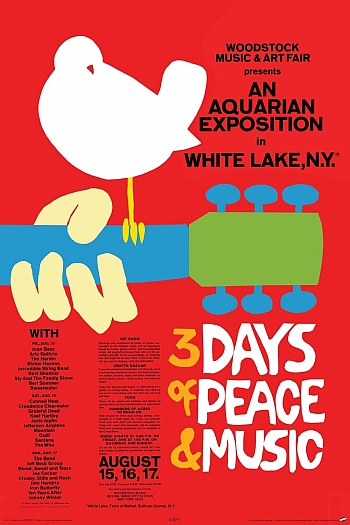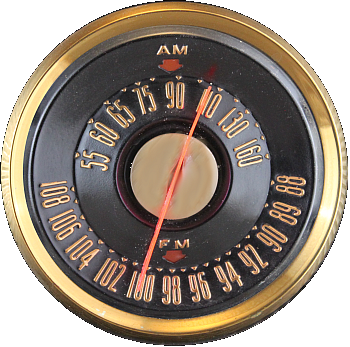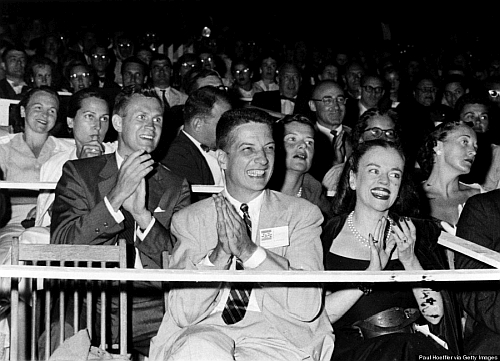The festival business is getting bigger than ever. According to one U.S. booking agency there were 847 bona fide festivals last year (2014) in North America alone, and thousands more around the world. While music sales and concert attendance dwindle, festivals are on a definite upswing. That’s a big change from the late 1980s and early 1990s when many of the established festivals, including Mariposa and the Newport Folk and Jazz Festivals were forced to re-locate and even shut down for a few years. Most of them are back now, stronger, if not bigger, than ever. That trend continues in our post-Covid world.
Festivals got really big in the 1960s and collectors of festival memorabilia, posters, buttons, recordings and the like, focus on festivals in that period, especially Woodstock, but music festival history goes back a lot farther.
The Greeks had music festivals before they had Olympics. The Pythian Games were more of a contest than a festival but that element remains today in festivals like the Shelburne Fiddle Contest and the Kiwanis Music Festival.
The first festivals where people paid money to immerse themselves in music for a few days began in the early 1800s in Britain and Europe. They mostly involved classical music and were much favoured by the new middle class who were just beginning to appreciate the classics. Of course there were plenty of concerts in fine halls but at the time they were focused on current music; festivals gave people the opportunity to hear pieces by composers from different eras and different countries, usually in an idyllic, country estate setting. More than just a concert, festivals were an experience, a romanticized version of upper crust life.
At the same time there was a growing interest in music of the peasants, driven by the fear that industrialization would soon cause it to disappear. The Irish Music Festival, held in Dublin in 1897 may have been the first folk festival. The Mountain Dance and Folk Festival, which is still held annually in Asheville, North Carolina can trace its origins back to 1928 and is considered to be the oldest still in existence.
Jazz festivals began to appear in Europe around 1950. The first ones were small affairs held on private estates in resort areas such as Cote D’Azure in France where war-weary European elites could indulge in romantic fantasies of a world completely different from their own. Of course the festivals soon became much larger and commercial but the same principal applied.
In all cases, people often travelled a significant distance to hear and learn about music that was outside their normal experience. It was great for the musicians too, not only could they play before new audiences; they could meet and jam with each other as well as mingle with the fans. Veterans could teach the young ‘uns, a good time was to be had by all as long as the weather cooperated.
 Things really got going in the 1960s. Newport had established a beach head for jazz and folk, the blues revival was bringing on more festivals and then there was Woodstock. That single weekend changed life as we know it and transformed the universe into something completely different. OK it changed the festival universe at least. With an estimated 500,000 attendees (who mostly didn’t pay) Woodstock made music festivals big business. The music changed too, Woodstock (and its predecessor Monterey Pop) featured top name mainstream acts, and the casual atmosphere mostly vanished. Films and recordings of the performances were widely seen and made many more people wish they were there. If you missed the real show the next best thing is to collect its artifacts.
Things really got going in the 1960s. Newport had established a beach head for jazz and folk, the blues revival was bringing on more festivals and then there was Woodstock. That single weekend changed life as we know it and transformed the universe into something completely different. OK it changed the festival universe at least. With an estimated 500,000 attendees (who mostly didn’t pay) Woodstock made music festivals big business. The music changed too, Woodstock (and its predecessor Monterey Pop) featured top name mainstream acts, and the casual atmosphere mostly vanished. Films and recordings of the performances were widely seen and made many more people wish they were there. If you missed the real show the next best thing is to collect its artifacts.
The value of festival memorabilia usually depends on who played there; posters with the names of the performers on them get the most interest but badges, ticket stubs, original photos and anything else related to an important festival can find a market. Promoters of festivals and concerts often hired high quality graphic artists for their advertising and many collectors will focus on the work of certain artists. Of course original Woodstock ephemera are almost non-existent but reproductions abound and most will settle for that. Copies of the original poster are printed on just about anything or for about a hundred bucks you can get a high-quality giclee print that looks almost as good as the original.
For the next fifteen years huge rock festivals sprung up all over the world, many were just one-time events, some attempted annual shows. One, on the Isle of Wight drew an amazing 700,000 people beating Woodstock’s attendance by a long shot. These mammoth festivals were choked by their own success. People who live nearby tend not to like that kind of thing. Besides where’s the fun in watching a show from almost a mile away? As the baby boomers that flocked to festivals grew up, the big rock festivals faded away.
Fortunately, small, community festivals flourished. They have all the advantages of the traditional festivals, usually focusing on one type of music, though not exclusively. If times got tough a community could give its economy a shot in the arm without investing heavily in infrastructure just by putting on a festival. Gradually, the large extravaganzas, including Woodstock, came back.
The biggest ones right now, Coachella in California and Bonnaroo in Tennessee are relative newcomers, having been born in this century. They feature all kinds of commercial, pop music from the biggest headliners in the business as well as unknown up-and-comers
The new festivals are different; they are much better organized, offer more stages and more diversity. There’s no rolling around in the mud, there are now luxury camps, called glamps, with proper plumbing. They do maintain the tradition of over-priced food and drink though.
Today people flock to major festivals to celebrate their own musical community, not learn about someone else’s.
Country probably has the largest, and certainly the most dedicated fan base but another, surprising form of music rivals it; disco. Not really disco but the modern form of it, Electronic Dance Music or EDM is huge. There are hundreds of massive festivals all over the world where people come to watch not musicians but DJs. These DJs don’t play vinyl records though; their shows are very high tech and stunningly visual.
How long can it last? Logic tells you that they can only grow so far and then the bubble will burst. Too many festivals chasing too few headliners will drive up prices. General admission at Coachella is already $399 US and that just gets you in the gate, at some point you just say enough already.
The big ones have their place for those that like them but thank goodness we still have the small ones around where you can have a sense of community and enjoy some music you’d never get to hear anywhere else.

